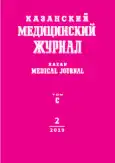Изучение биохимических маркёров у новорождённых с некротическим энтероколитом
- Авторы: Мехтиева С.А.1, Насирова С.Р.1, Рагимова Н.Д.1, Гафаров И.А.2
-
Учреждения:
- Научно-исследовательский институт педиатрии им. К.Я. Фараджевой
- Азербайджанский медицинский университет
- Выпуск: Том 100, № 2 (2019)
- Страницы: 232-238
- Тип: Теоретическая и клиническая медицина
- URL: https://journals.rcsi.science/kazanmedj/article/view/11532
- DOI: https://doi.org/10.17816/KMJ2019-232
- ID: 11532
Цитировать
Полный текст
Аннотация
Цель. Изучение уровня биохимических маркёров для оптимизации диагностики и прогнозирования некротического энтероколита у новорождённых.
Методы. Под наблюдением находились 110 новорождённых с некротическим энтероколитом, поступивших в отделение реанимации и интенсивной терапии в возрасте от 1 до 28 дней. Согласно стадиям некротического энтероколита все обследованные новорождённые были разделены на три группы. Первую группу составили 49 (40,5%) новорождённых с некротическим энтероколитом I стадии, вторую группу - 48 (39,7%) детей с некротическим энтероколитом II стадии, третью группу - 13 (10,7%) новорождённых с некротическим энтероколитом III стадии. У 40 новорождённых с некротическим энтероколитом иммуноферментным анализом в крови определяли матриксные металлопротеиназы-2, -9 и -17, кателицидин, трансферрин, в кале - фекальный кальпротектин.
Результаты. В результате сравнительного анализа было установлено, что уровень металлопротеиназы-2 у новорождённых в первой группе увеличивался в 6,9 раза, во второй группе - в 8,3 раза, в третьей группе - в 10,7 раза. Аналогичным образом содержание металлопротеиназы-9 повышалось в 3 раза в первой группе, в 3,4 раза - во второй группе, в 4,5 раза - в третьей группе по сравнению с новорождёнными контрольной группы. Концентрация металлопротеиназы-17 у новорождённых в первой и второй группах была почти одинакова, повышена в среднем в 2,5 раза, a в третьей группе - в 3,6 раза по сравнению с контролем. У обследованных новорождённых наиболее высокий уровень кателицидина и низкий уровень трансферрина отмечен при некротическом энтероколите III стадии, что свидетельствует о более тяжёлом течении заболевания и может быть предиктором для изменения лечебной тактики. По данным исследования, учитывая общий диагностический вес теста фекального кальпротектина (75%), его можно использовать как неинвазивный маркёр воспаления в кишечнике.
Вывод. Установленные изменения уровня биохимических маркёров (металлопротеиназ, кателицидина, трансферрина в крови и фекального кальпротектина в кале) имеют диагностическую и прогностическую значимость в диагностике, прогнозировании исходов, оптимизации лечения некротического энтероколита в неонатальной практике.
Полный текст
Открыть статью на сайте журналаОб авторах
Севиндж Амил кызы Мехтиева
Научно-исследовательский институт педиатрии им. К.Я. Фараджевой
Автор, ответственный за переписку.
Email: nauchnayastatya@yandex.ru
г. Баку, Азербайджан
Севиндж Рамиз кызы Насирова
Научно-исследовательский институт педиатрии им. К.Я. Фараджевой
Email: nauchnayastatya@yandex.ru
г. Баку, Азербайджан
Наиля Джалил кызы Рагимова
Научно-исследовательский институт педиатрии им. К.Я. Фараджевой
Email: nauchnayastatya@yandex.ru
г. Баку, Азербайджан
Исмаил Адиль оглы Гафаров
Азербайджанский медицинский университет
Email: nauchnayastatya@yandex.ru
г. Баку, Азербайджан
Список литературы
- Карпова И.Ю. Некротический энтероколит у новорождённых: клиника, диагностика и лечение. СТМ. 2012; (2): 138-142.
- Afrazi A., Sodhi C.P., Richardson W. et al. New insights into the pathogenesis and treatment of necrotizing enterokolitis: Toll-like receptors and beyond. Pediatr. Res. 2011; 69: 183-188. doi: 10.1203/PDR.0b013e3182093280.
- Gfroerer S., Fiegel H., Schloesser R.L., Rolle U. Primary laparotomy is effective and safe in the treatment of necrotizing enterocolitis. World J. Surg. 2014; 1: 766-771. doi: 10.1007/s00268-014-2615-y.
- Neu J., Walker W.A. Necrotizing enterocolitis. N. Eng. J. Med. 2011; 364: 255-264. doi: 10.1056/NEJMra1005408.
- Markel T.A., Crisostomo P.R., Wairiuko G.M. et al. Cytokinesin necrotizing enterocolitis. Shock. 2006; 25: 329-337. doi: 10.1097/01.shk.0000192126.33823.87.
- Насирова С.Р., Мехтиева С.А., Гусейнова Н.Г. Клинико-иммунологические особенности некротического энтероколита у новорождённых. Научный альманах. 2016; (3-3): 333-338.
- Bergholz R., Zschiegner M., Eschenburg G. et al. Mucosal loss with increased expression of IL-6, IL-8, and COX-2 in a formula-feeding only neonatal rat model of necrotizing enterocolitis. J. Pediatr. Surg. 2013; 48 (11): 2301-2307. doi: 10.1016/j.jpedsurg.2013.04.028.
- Hull M.A., Fisher J.G., Gutierrez I.M. et al. Mortality and management of surgical necrotizing enterocolitis in very low birth weight neonates: A prospective cohort study. J. Am. Coll. Surg. 2014; 6: 1148-1155. doi: 10.1016/j.jam collsurg.2013.11.015.
- Löffek S., Schilling O., Franzke C.-W. Biological role of matrix metalloproteinases: a critical balance. Eur. Respir. J. 2011; 38: 191-208. doi: 10.1183/09031936. 00146510.
- Wang Y., Johnson A.R., Ye Q.Z., Dyer R.D. Catalytic activities and substrate specificity of the human membrane type 4 matrix metalloproteinase catalytic domain. J. Biol. Chem. 1999; 274 (46): 33 043-33 049. doi: 10.1074/jbc.274.46.33043.
- Itoh Y., Kajita M., Kinoh H. et al. Membrane type 4 matrix metalloproteinase (MT4-MMP, MMP-17) is a glycosylphosphatidylinositol-anchored proteinase. J. Biol. Chem. 1999; 274 (48): 34 260-34 266. doi: 10.1074/jbc. 274.48.34260.
- Мазанкова Л.Н., Горбунов С.Г., Юнес Б. Фекальный кальпротектин как маркёр воспаления толстой кишки при разных вариантах течения Clostridium difficile-инфекции у детей. Детские инфекции. 2013; 2: 12-16.
- Азимова В.Т., Потатуркина-Нестерова Н.И., Нестеров А.С. Эндогенные антимикробные пептиды человека. Соврем. пробл. науки и образования. 2015; (1). https://www.science-education.ru/ru/article/view?id=17746 (дата обращения: 15.10.2108).
Дополнительные файлы






